This sample Drinking Water Pollution Research Paper is published for educational and informational purposes only. If you need help writing your assignment, please use our research paper writing service and buy a paper on any topic at affordable price. Also check our tips on how to write a research paper, see the lists of health research paper topics, and browse research paper examples.
Water Pollution
Water is an essential constituent of life. One of the key cornerstones of public health and community health is access to safe water. Throughout history, polluted water has frequently led to waterborne disease outbreaks with acute and long-term health effects ranging from diarrhea to death. Polluted water is often the main human exposure pathway to infectious pathogens and carcinogenic organic and inorganic contaminants. During the last few decades, the increase in the human population as well as globalization and its effects have not only raised the quantity of waste, but has also introduced several emerging water contaminants (e.g., pharmaceuticals, hormones, endocrinedisrupting chemicals, viruses, and toxins). As analytical methods continue to improve, recent studies have revealed that emerging or re-emerging microbiological pathogens or chemicals may be present in natural or treated water bodies. Emerging contaminants, which have not historically been considered pollutants, have now raised significant concerns to public health professionals and environmental engineers and scientists.
Most water pollutants originate from human activity, while a small percentage of them have their sources in natural activities such as volcanic eruptions. Primary anthropogenic sources of water pollution include poorly treated or untreated municipal sewage, individual septic systems discharge, agricultural livestock wastes, fertilizers, pesticides, industrial chemical wastes, spilled petroleum products, mine drainage, spent solvents, etc. Once pollutants are introduced into receiving surface water and groundwater bodies via discharge processes, surface runoff, subsurface infiltration, or atmosphere precipitation, they are transported within the water cycle in a global context. Pollutants also undergo various physical, chemical, and biological transformations.
Pollutants in water may cause waterborne diseases after exposure or ingestion of contaminated water. For instance, pathogenic microorganisms frequently cause gastrointestinal illnesses and chemical pollutants may damage major organs (e.g., liver and kidney) and functional systems (e.g., nervous and immune) and increase cancer risk. The major categories of water pollutants are microbiological, chemical, and radioactive. Table 1 summarizes drinking-water contaminants listed by the United States Environmental Protection Agency. The table includes regulated contaminants, that is, National Primary and Secondary Drinking Water Regulations (NPDWRs and NSDWRs). The table also includes nonregulated contaminants listed in the Contaminant Candidate List 2 (CCL2) that was compiled by the United States Environmental Protection Agency.
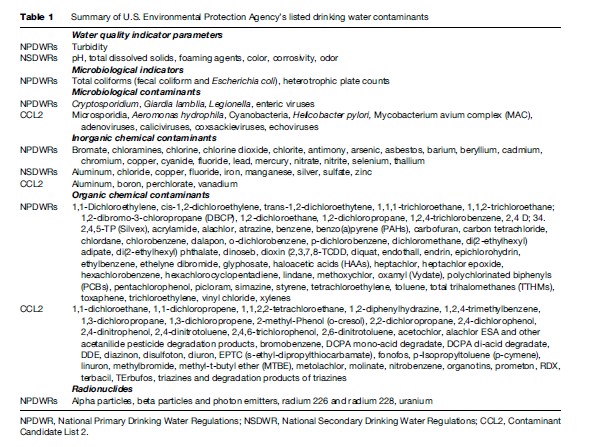
Regulations
The potential threat associated with contaminated drinking water has prompted federal governments and organizations to promulgate source-water and drinking-water regulations. Drinking-water standards vary among countries and regions mainly due to differences in the context of local social, cultural, economic, and environmental conditions. The World Health Organization (WHO) has established Guidelines for Drinking-Water Quality (1st–3rd editions) that provide a scientific point of departure for national authorities to develop drinking-water regulations and standards appropriate for each national situation.
In addition, the Council of the European Union (EU) has implemented directives on the quality of water intended for human consumption (i.e., EU Council Directive 80/778/EEC and 98/83/EC). Many European countries have set up national legislations to govern their water intended for human consumption based on these EU Council directives. Like the United States, most European countries have similar regulatory systems administered by federal environmental agencies and local governments. However, England and Wales have developed a unique tripartite regulation system involving the Environment Agency, the Drinking Water Inspectorate (DWI), and the Office of Water Services (Ofwat).
In 1974, the United States Congress passed the Safe Drinking Water Act (SDWA) under which the U.S. Environmental Protection Agency (USEPA) is in charge of establishing drinking-water regulations. The SDWA law was amended in 1986 and 1996 for taking further actions to protect not only treated drinking water but also its sources. Microbial contamination in drinking water is regulated by several rules, including the Total Coliform Rule (TCR), Surface Water Treatment Rule (SWTR), Interim Enhanced SWTR (IESWTR), Long Term 1 Enhanced SWTR (LT1ESWTR), and Long Term 2 Enhanced SWTR (LT2ESWTR). These rules are intended to protect the public against exposure to pathogens such as coliform, Giardia lamblia, Cryptosporidium spp., Legionella spp., and viruses. Under the SWTR, the USEPA set maximum contaminant level goals of zero for Giardia lamblia, viruses, and Legionella pneumophila. This rule is applied to public water systems (serving 10 000 persons) and surface water or ground water under the direct influence of surface water.
Additionally, the Disinfectants and Disinfection ByProducts (D-DBPs) Regulation and the Stage 2 D-DBP Rule (or DBPR2) require public water systems to meet maximum contaminant levels for total trihalomethanes and five haloacetic acids at each monitoring site in the distribution system. In 2006, the United States finalized the Ground Water Rule to protect the public from pathogen contamination in systems that use groundwater. Microorganisms such as viruses are regulated under the Ground Water Rule.
Currently, the USEPA has set the National Primary Drinking Water Regulations (NPDWRs or primary standards) (which went into effect in 1977) and the National Secondary Drinking Water Regulations (NSDWRs or secondary standards). The NPDWRs regulate about 90 contaminants including some infectious microorganisms and harmful chemicals or radionuclides. The NSDWRs consist of nonenforceable guidelines regulating contaminants that may cause cosmetic effects (e.g., skin or tooth discoloration) or aesthetic effects (e.g., taste, odor, or color) in drinking water.
In addition, the SDWA Amendment of 1996 requires the USEPA to select a group of known or potential drinking water contaminants periodically (approximately every 5 years) for regulatory consideration. In 1998, the USEPA published the first drinking water Contaminant Candidate List (CCL) that included ten microbial and 50 chemical contaminants. The second Contaminant Candidate List (CCL2) (published in 2005) carries forward 51 (of the original 60) unregulated contaminants from the CCL1, including nine microbial and 42 chemical contaminants. Furthermore, the 1996 SDWA Amendment also requires the USEPA to establish criteria for a program to monitor unregulated contaminants. The Unregulated Contaminant Monitoring Regulation (UCMR) program is used to collect data for contaminants suspected to be present in drinking water but that do not have health-based standards set under the Safe Drinking Water Act. Analytical results are stored in a National Contaminant Occurrence Database that serves as the primary source of occurrence and exposure data for EPA to determine whether or not to regulate particular contaminants.
In the United States, the regulatory structure for drinking water has been expanded to the protection of source water, pipe-end tap water, and bottled water. For instance, the final 1991 Lead and Copper Rule (LCR) established a treatment technique to prevent lead and copper from leaching into drinking water during distribution. The rule requires public water suppliers to treat their water to make it as minimally corrosive as possible to metals in their customers’ plumbing systems. Additionally, the quality of bottled water is currently regulated by the U.S. Food and Drug Administration (FDA) using the USEPA tap water standards as a template.
Tables 2 and 3 summarize drinking-water standards of the United States, European Union, and those recommended by WHO. The regulated contaminants and their guideline values are very diverse among these drinking-water standards. Some contaminants listed in U.S. drinking-water standards (e.g., aluminum, chloride, sulfate, zinc, chlorobenzene, dioxin, polychlorinated biphenyls, and trichloroethylene) are not included in EU and WHO standards. For those contaminants regulated by the United States, the European Union, and WHO, most of the guideline values are similar but not identical.
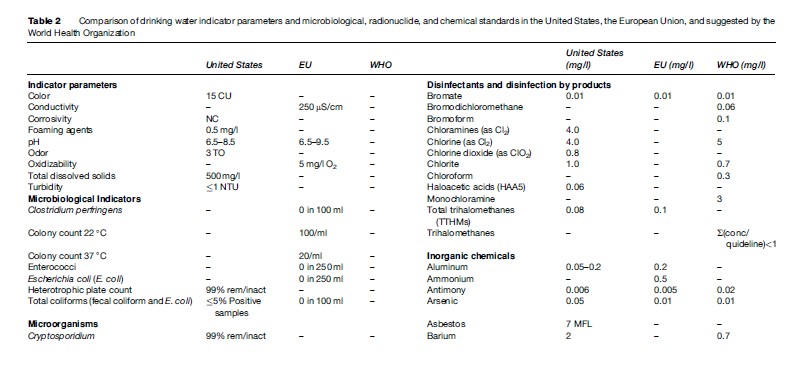
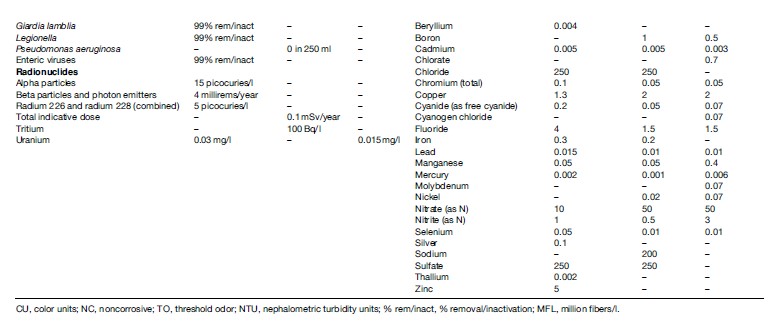
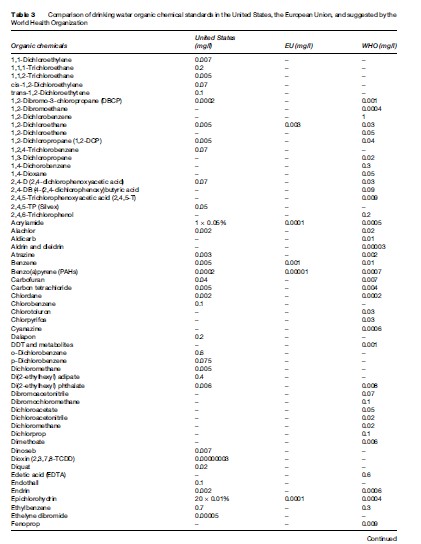
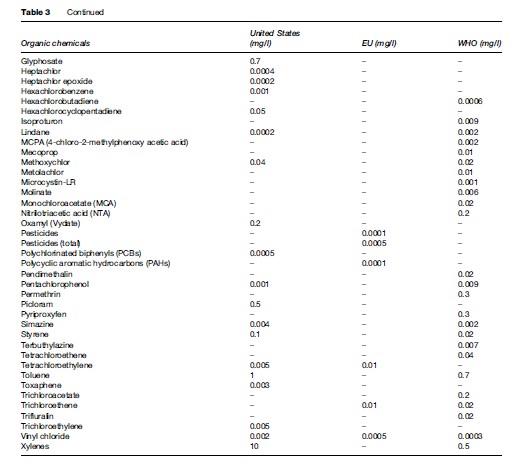
Waterborne Disease Outbreaks
Poor water quality poses a major threat to human health. According to WHO, diarrhea disease alone amounts to an estimated 4.1% of the total daily global burden of disease and is responsible for the death of 1.8 million people every year. A significant amount of disease could be prevented, especially in developing countries, through access to safe water. It has been reported that 1.5–12 million people die per year from waterborne diseases (Gleick, 2002; WHO, 2004).
However, the number of worldwide waterborne-disease cases and deaths summarized from the outbreak reports received by World Health Organization (WHO) during 2001–06 (Table 4) are much lower than those estimated values. The true incidence of waterborne illnesses is not reflected by the currently reported statistics. Multiple factors influence whether waterborne outbreaks are recognized, investigated, and reported. These factors include public awareness, availability of laboratory testing, requirements for reporting diseases, and resources available to local communities and health-care units. Even though the outbreaks reported in Table 4 do not reflect the actual number, they provide important information on the trends of observed waterborne diseases worldwide. It appears that acute watery diarrhea, cholera, and typhoid fever are the major reported waterborne diseases. The majority of these outbreak cases were reported in Africa and some in Asia. It is important to note that the reported disease outbreaks do not take into account chronic health effects and inheritable mutations that could occur in case of exposure to chemical, biological, or radioactive materials.

In the United States, the Centers for Disease Control and Prevention (CDC) publishes surveillance summaries for waterborne disease and outbreaks associated with drinking water approximately every 2 years. Table 5 summarizes numbers of waterborne-disease outbreaks associated with drinking water. In the last decade, thousands of people in the United States were infected by waterborne diseases every year, many of whom were hospitalized. Many of these waterborne-disease outbreaks were associated with groundwater consumption, which was not treated in community water systems. Some of the outbreaks are related to treated surface waters.
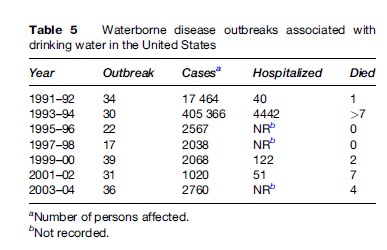
According to Craun et al. (2006), during the 12-year period of 1991–2002, 207 waterborne disease outbreaks and 433 947 illnesses were reported in the United States; slightly more outbreaks occurred in noncommunity water systems (42%) than either community (36%) or individual systems such as private wells (22%). Public water systems are identified as community or noncommunity based on definitions of the Safe Drinking Water Act. A community water system serves year-round residents (an average of 25 or more persons or 15 or more service connections). Noncommunity systems can serve nontransient (schools, hospitals, factories) systems with their own water supply or transient systems with their own water supply (campgrounds, motels, gas stations).
Table 6 presents the number of waterborne-disease outbreaks associated with drinking water categorized by etiologic agent. Most of the waterborne disease outbreaks were related to microbial agents (i.e., parasites, bacteria, and viruses). Several cases were associated with exposure to chemicals such as nitrite, fluoride, and chlorine. Some of the outbreaks involved unidentified agents. The failure to identify etiologic agents causing the waterborne disease is most likely due to lack of sensitive analytical techniques. For example, a newest surveillance summary from the Centers for Disease Control and Prevention (CDC) showed that one-sixth (five out of 30 cases) of drinking-water-associated WBDOs during 2003–04 involved unknown agents that cannot be detected and identified by currently available analytical methods (Liang et al., 2006). It is speculated that in a large percentage of the unidentified causes of waterborne outbreaks, the responsible agent is viral.
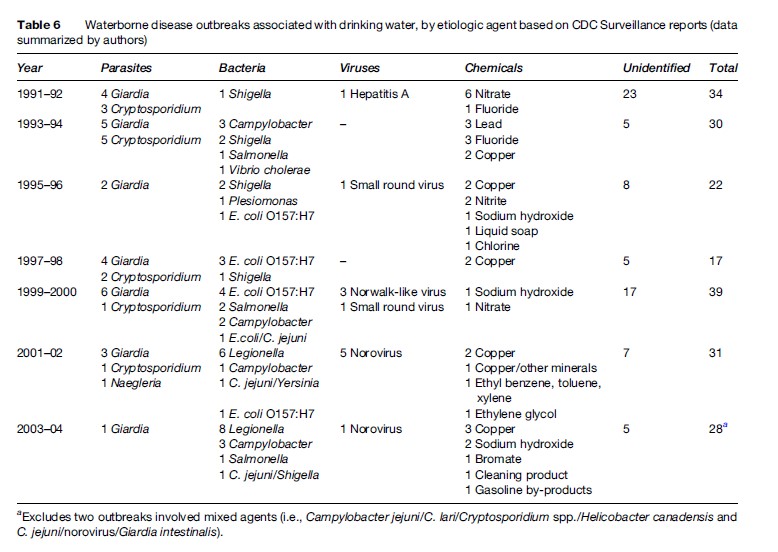
Emerging Water Contaminants
Emerging water contaminants can be broadly defined as any chemical or microorganism that is not commonly monitored in water but whose documented incidences have increased recently and may cause known or suspected adverse ecological and/or human health effects. A variety of chemical substances and microorganisms that have not historically been considered as pollutants have now emerged as prominent agents that may cause waterborne disease. Some of the causes associated with emergence are changes in human behavior, demographic changes, landscape changes, water resources development projects, developing technology, increased travel, microbial adaptation, climate changes, and improved scientific methods of detection and analysis. New analytical techniques and improved understanding of science and engineering lead to the understanding of the risk on human and environmental health that may be posed by emerging contaminants. A list of emerging contaminants is provided in Table 7. These include pharmaceuticals, microorganisms, algal toxins, and various chemicals. To control and regulate emerging contaminants in water, we need better understanding of their characteristics, occurrence, transport pathways, ultimate fate, health effects, detection methods, and treatment potential. This research paper provides an overview of three representative types of emerging contaminants: cyanotoxins (chemical contaminants produced by living organisms), pharmaceuticals (human-made chemical contaminants), and microorganisms (biological contaminants). These representative examples are not considered more or less important than other emerging contaminants.
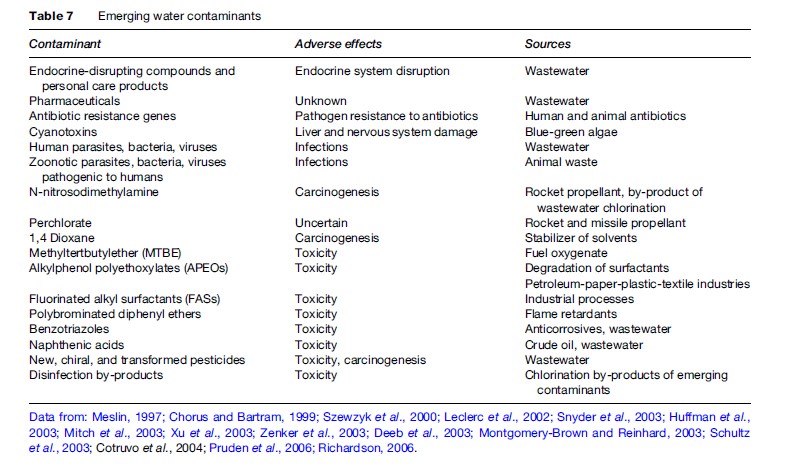
Examples Of Emerging Water Contaminants
Cyanotoxins
Fresh water toxins produced by cyanobacteria, or bluegreen algae, are generally referred to as cyanotoxins. At least 19 of the more than 50 cyanobacteria genera have been shown to exhibit toxic properties. About 60% of the blooms associated with toxin-producing cyanobacteria are toxic. Anabaena, Aphanizomenon, Microcystis, and Oscillatoria are a few examples of the toxin-producing genera, but only a few of the toxins from these genera have been isolated and identified. Blooms of toxic cyanobacteria have occurred worldwide for many years and have led to illness in humans and to the death of animals. The reported number of cyanobacteria blooms has increased due to increased nutrient loading from farming, urban runoff, and treated wastewater. Drinking-water treatment plants that treat surface waters are at risk for cyanotoxin contamination if a toxin-producing bloom develops in the source water.
Cyanotoxins may be classified as hepatotoxins (toxins that affect the liver) or neurotoxins (toxins that affect the nervous system). Microcystin, nodularin, and cylindrospermopsin are hepatotoxins that may cause internal hemorrhage or death, in case of acute exposure to high doses, and carcinogenesis in case of long-term exposure. Anatoxins and saxitoxins are neurotoxins that may cause paralysis, respiratory failure, or death. Occurrence data suggest that hepatotoxins are the most prevalent of the cyanotoxins. Microcystins are a group of hepatotoxins that were named after the first organism found to produce them, Microcystis aeruginosa. Microcystin and microcystinproducing species of cyanobacteria have been found worldwide and microcystin-LR has been identified as one of the toxins of highest priority. In the United States, this prioritization was based on four criteria: Human health effects, occurrence, susceptibility to drinkingwater treatment, and toxin stability. In 1998, the World Health Organization stressed the potential public health importance of the occurrence of microcystin in drinking water and adopted a provisional guideline value for microcystin-LR of 1.0 mg/l. Drinking water guidelines of 1.3 mg/l and 1.5 mg/l have been proposed in Australia and Canada, respectively. In the United States, microcystinLR and other cyanotoxins are not yet regulated but they are currently on the USEPA Contaminant Candidate List.
Pharmaceuticals
Pharmaceuticals in the water supply have become a concern over the past 10 years. With the development of better detection methods, researchers are identifying pharmaceuticals and personal care products in wastewater, drinking water, and surface water. In the past, the environmental fate and effect of human pharmaceuticals was largely ignored since their benefit was assumed to greatly outweigh any environmental concern. The benefits of pharmaceuticals have been well established but the risks are unknown and often unrecognized.
Pharmaceuticals may enter the aquatic environment in a variety of ways. Most commonly, a human ingests a pharmaceutical and excretes either a partially or fully metabolized form of the drug, which is disposed of through wastewater. Subsequently, pharmaceuticals are discharged to the environment in sewage effluent when they are not completely degraded in sewage treatment plants. Pharmaceuticals such as antibiotics are administered to animals at very high doses during veterinary procedures. Animal excretion is a major source of contamination. Other sources include aquacultures, pharmaceutical production plants, and run-off from the application of manure or sewage sludge to agricultural fields.
Although the concentrations of pharmaceuticals in water are usually very small, their presence raises concerns regarding their impact on human health. Most studies on the therapeutic effects of drugs are based on the short-term ingestion of relatively high doses. Little is known about potential health effects associated with long-term chronic ingestion of low concentrations through drinking water. Also, there is a possibility that exposure to multiple pharmaceuticals, even at low concentrations, may have synergistic human health consequences. Furthermore, the fate and transformation pathways of pharmaceuticals in water and wastewater treatment utilities are largely unknown. Water and wastewater undergo a series of physicochemical processes. These processes, like chlorination, degrade pharmaceuticals, alter their consistency, affect their fate, and create by-products. There are indications that routine wastewater or drinking water chlorination may transform specific pharmaceuticals to more toxic compounds. The degraded or transformed pharmaceutical compounds reach the public through the consumption of drinking water. In addition, a major health concern problem specifically related to antibiotics is the development of antibiotic resistance genes in pathogens of concern to humans.
Microorganisms
According to the Institute of Medicine, emerging pathogens are defined as those causing infectious diseases whose documented incidence in humans has increased during the past 20 years or threatens to rise in the near future. Of the microorganisms that cause this class of diseases, a number of viral, bacterial, and protozoan agents have been associated with outbreaks of waterborne illness. Several emerging pathogens have been identified in natural water sources and, hence, have the potential to cause disease outbreaks. Table 8 summarizes waterborne microbial contaminants that are currently considered emerging. An interesting category of microbiological contaminants are re-emerging pathogens, such as Vibrio cholerae, which is the pathogenic agent that causes cholera. There are a number of pathogens that are transmissible between species, and water may serve as a vehicle for human exposure. These are considered emerging pathogens for humans. Manure and other wastes of various agricultural animals contain high concentrations of infectious zoonotic pathogens such as viruses, protozoa, and bacteria, and manure application sites are a main cause of groundwater and surface water microbial pollution. Waterborne disease statistics estimate a growing global burden of infectious diseases from contaminated drinking water. It is estimated that currently consumption of water that is contaminated with pathogenic agents is one of the leading causes associated with human death and disease worldwide
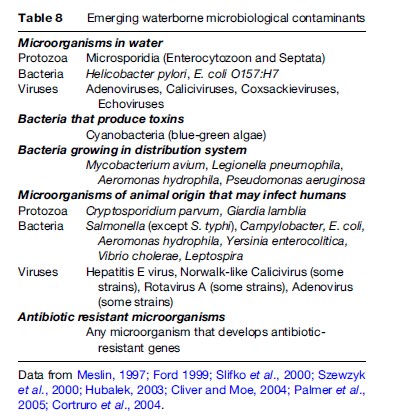
Pollution Control And Water Treatment
The removal and/or inactivation of waterborne pathogens has been a principal objective in the drinking water industry for approximately 100 years. Two of the most significant public health innovations were rapid-rate granular media filtration in the late 1800s and chemical disinfection in the early 1900s. Most surface water treatment plants have incorporated these technologies to establish a multiple treatment barrier approach to pathogen control that is now called conventional treatment. In the early 1900s, implementation of conventional treatment significantly reduced the number of typhoid and cholera outbreaks in the United States.
The conventional treatment sequence includes coagulation, flocculation, sedimentation, and granular media filtration. This process is followed by disinfection. Modifications to this conventional treatment sequence include direct filtration (coagulation followed by flocculation and granular media filtration) and in-line filtration (coagulation followed by granular media filtration). Optional clarification methods such as dissolved air flotation and sludge blanket clarification may be used in place of sedimentation in the conventional treatment process. Alternatives to the conventional treatment process include slow sand filtration and diatomaceous earth filtration. During the last few years, innovative technologies such as microfiltration and ultrafiltration membranes have been introduced and effectively applied in the drinkingwater treatment field. Table 9 summarizes currently used treatment processes. In most treatment plants, a combination of these technologies is used in a multiple treatment barrier approach.
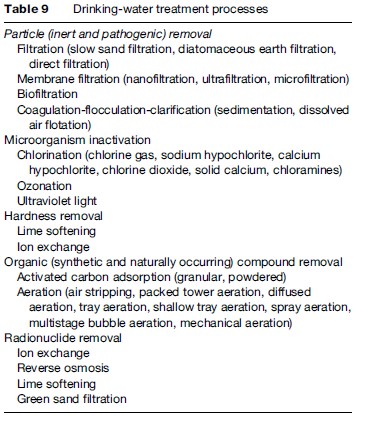
Treatment of water is probably one of the most important ways to protect public health. Even though treating water saves millions of lives each year, treatment might have its tradeoffs at times. For example, chlorination can effectively remove pathogens but at the same time increases the potential of exposure to carcinogenic chlorination by-products. Also, at times a treatment scheme may be effective in removing a set of contaminants but not very effective in removing others. There is a lot of research currently on the effectiveness of the existing treatment technologies in removing and inactivating emerging contaminants. It is a challenge to optimize operation of treatment utilities with a goal to effectively remove a wide array of contaminants.
Bibliography:
- Chorus I and Bartram J (1999) Toxic Cyanobacteria in Water: A Guide to their Public Health Consequences Monitoring and Management. Geneva, Switzerland: World Health Organization.
- Craun MF, Craun GF, Calderon RL, and Beach MJ (2006) Waterborne outbreaks in the United States. Journal of Water and Health 4(S2): 19–30.
- Deeb RA, Chu KH, Shih T, et al. (2003) MTBE and other oxygenates: Environmental sources analysis, occurrence, and treatment. Environmental Engineering Science 20(5): 433–447.
- Ford TE (1999) Microbiological safety of drinking water: United States and global perspectives. Environmental Health Perspectives 107(S1): 191–206.
- Gleick PH (2002) Dirty Water: Estimated Deaths from Water-Related Diseases 2000–2020. Pacific Institute Research Report. Oakland, CA: Pacific Institute for Studies in Development Environment, and Security.
- Hubalek Z (2003) Emerging human infectious diseases: Anthroponoses, zoonoses, and sapronoses. Emerging Infectious Diseases 9(3): 403–404.
- Huffman DE, Nelson KL, and Rose JB (2003) Calicivirus – An emerging contaminant in water. State of the Art Environmental Engineering Science 20(5): 503–515.
- Leclerc H, Schwartzbrod L, and Dei-Cas E (2002) Microbial agents associated with waterborne diseases. Critical Reviews in Microbiology 28(4): 371–409.
- Liang JL, Dziuban EJ, Craun GC, et al. (2006) Surveillance for waterborne disease and outbreaks associated with drinking water and water not intended for drinking – United States, 2003–2004. CDC Surveillance Summaries 55: 31–58.
- Meslin FX (1997) Global aspects of emerging and potential zoonoses: A WHO perspective. Emerging Infectious Diseases 3(2): 223–228.
- Mitch WA, Sharp JO, Trussell RR, Valentine RL, Alvarez-Cohen L, and Sedlak DL (2003) N-Nitrosodimethylamine (NDMA) as a drinking water contaminant: A review. Environmental Engineering Science 20 (5): 389–404.
- Montgomery-Brown L and Reinhard M (2003) Occurrence and behavior of alkylphenol polyethoxylates in the environment. Environmental Engineering Science 20(5): 471–486.
- Palmer S, Brown D, and Morgan D (2005) Early qualitative risk assessment of the emerging zoonotic potential of animal diseases. British Medical Journal 331: 1256–1260.
- Pruden A, Pei R, Storteboom H, and Carlson K (2006) Antibiotic resistance genes as emerging contaminants: Studies in northern Colorado. Environmental Science and Technology 40(23): 7445–7450.
- Richardson SD (2006) Environmental mass spectrometry: Emerging contaminants and current issues. Analytical Chemistry 78(12): 4021–4045.
- Schultz MM, Barofsky DF, and Field JA (2003) Fluorinated alkyl surfactants. Environmental Engineering Science 20(5): 487–501.
- Slifko TR, Smith HV, and Rose JB (2000) Emerging parasite zoonoses associates with water and food. International Journal of Parasitology 30: 1379–1393.
- Snyder SA, Westerhoff P, Yoon Y, and Sedlak DL (2003) Pharmaceuticals, personal care products, and endocrine disruptors in water: Implications for the water industry. Environmental Engineering Science 20(5): 449–469.
- Szewzyk U, Szewzyk R, Manz W, and Schleifer KH (2000) Microbiological Safety of Drinking Water. Annual Review of Microbiology 54: 81–127.
- World Health Organization (2004) Water Sanitation and Health. Geneva, Switzerland: World Health Organization.
- Xu J, Song Y, Min B, Steinberg L, and Logan BE (2003) Microbial degradation of perchlorate: Principles and applications. Environmental Engineering Science 20(5): 405–422.
- Zenker MJ, Borden RC, and Barlaz MA (2003) Occurrence and Treatment of 1,4-dioxane in aqueous environments. Environmental Engineering Science 20(5): 423–432.
See also:
Free research papers are not written to satisfy your specific instructions. You can use our professional writing services to buy a custom research paper on any topic and get your high quality paper at affordable price.








